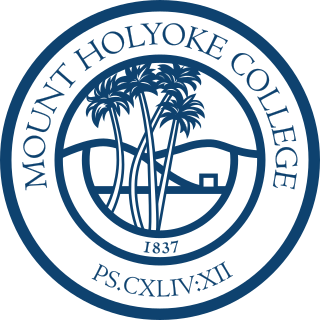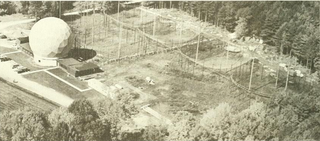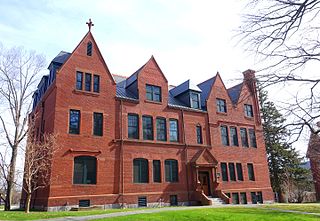This article needs additional citations for verification .(March 2018) |
Museums10 is a consortium of art, science, and history museums in Western Massachusetts. It includes art museums from the Five Colleges and Historic Deerfield.
This article needs additional citations for verification .(March 2018) |
Museums10 is a consortium of art, science, and history museums in Western Massachusetts. It includes art museums from the Five Colleges and Historic Deerfield.

Amherst is a town in Hampshire County, Massachusetts, United States, in the Connecticut River valley. As of the 2020 census, the population was 39,263, making it the highest populated municipality in Hampshire County. The town is home to Amherst College, Hampshire College, and the University of Massachusetts Amherst, three of the Five Colleges. The name of the town is pronounced without the h ("AM-erst") by natives and long-time residents, giving rise to the local saying, "only the 'h' is silent", in reference both to the pronunciation and to the town's politically active populace.

Mount Holyoke College is a private liberal arts historically women's college in South Hadley, Massachusetts. It is the oldest member of the historic Seven Sisters colleges, a group of elite historically women's colleges in the Northeastern United States.

Deerfield is a town in Franklin County, Massachusetts, United States. Settled near the Connecticut River in the 17th century during the colonial era, the population was 5,090 as of the 2020 census. Deerfield is part of the Springfield, Massachusetts Metropolitan Statistical Area in western Massachusetts, lying 30 miles (48 km) north of the city of Springfield.

The Five College Consortium comprises four liberal arts colleges and one university in the Connecticut River Pioneer Valley of Western Massachusetts: Amherst College, Hampshire College, Mount Holyoke College, Smith College, and the University of Massachusetts Amherst, totaling approximately 38,000 students. They are geographically close to one another and are linked by frequent bus service which operates between the campuses during the school year.

The Pioneer Valley is the colloquial and promotional name for the portion of the Connecticut River Valley that is in Massachusetts in the United States. It is generally taken to comprise the three counties of Hampden, Hampshire, and Franklin. The lower Pioneer Valley corresponds to the Springfield, Massachusetts metropolitan area, the region's urban center, and the seat of Hampden County. The upper Pioneer Valley region includes the smaller cities of Northampton and Greenfield, the county seats of Hampshire and Franklin counties, respectively.

The Five College Radio Astronomical Observatory (FCRAO) was a radio astronomy observatory located on a peninsula in the Quabbin Reservoir. It was sited in the town of New Salem, Massachusetts on land that was originally part of Prescott, Massachusetts. It was founded in 1969 by the Five College Astronomy Department. From its inception, the observatory has emphasized research, the development of technology and the training of students—both graduate and undergraduate.

Western Massachusetts is a region in Massachusetts, one of the six U.S. states that make up the New England region of the United States. Western Massachusetts has diverse topography; 22 colleges and universities, with approximately 100,000 students; and such institutions as Tanglewood, the Springfield Armory, and Jacob's Pillow.
WFCR is a non-commercial FM radio station licensed to Amherst, Massachusetts. It serves as the National Public Radio (NPR) member station for Western Massachusetts, including Springfield. The station operates at 13,000 watts ERP from a transmitter on Mount Lincoln in Pelham, Massachusetts 968 feet above average terrain. The University of Massachusetts Amherst holds the license. The station airs NPR news programs during the morning and afternoon drive times and in the early evening. Middays and overnights are devoted to classical music and jazz is heard during the later evening hours.

The Mount Holyoke College Art Museum in South Hadley, Massachusetts, is located on the Mount Holyoke College campus and is a member of Museums10. It is one of the oldest teaching museums in the country, dedicated to providing firsthand experience with works of significant aesthetic and cultural value. The works in the museum's collection can be searched on the database maintained by the Five College Museums/Historic Deerfield.
Janet Wilder Dakin, was an American philanthropist and zoologist, known for her animal advocacy and environmental work.
The Five Colleges and Historic Deerfield Museum Consortium is a consortium of museums in Western Massachusetts and includes art museums which are part of the Five Colleges as well as Historic Deerfield. The Five College Museums maintains a searchable database of the collections of the museums that is among the larger art galleries on the internet. These museums also participate in Museums10.
Franklin Kessel Patterson was a professor and author, and the first president of Hampshire College in Amherst, Massachusetts. He was also, along with the other presidents of the Five Colleges, a co-author of the New College Plan.

The Holyoke Range or Mount Holyoke Range is a traprock mountain range located in the Connecticut River Valley of Massachusetts. It is a sub-range of the narrow, linear Metacomet Ridge that extends from Long Island Sound near New Haven, Connecticut north through the Connecticut River Valley of Massachusetts to the Vermont border. A popular hiking destination, the range is known for its anomalous east–west orientation, high ledges and its scenic character. It is also notable for its unique microclimate ecosystems and rare plant communities, as well as significant historic sites, such as the Mount Holyoke Summit House and the Horse Caves.

Mount Norwottuck or Mount Norwottock, 1,106 feet (337 m) above sea level, is the highest peak of the Holyoke Range of traprock mountains located in the Connecticut River Valley of Massachusetts and part of the greater Metacomet Ridge which stretches from Long Island Sound to nearly the Vermont border. The peak rises steeply from the valley 1,000 feet (300 m) below and offers sweeping views of the surrounding countryside. It is located within the towns of Amherst and Granby, Massachusetts.

Bare Mountain, 1,014 feet (309 m) above sea level, is a prominent peak of the Holyoke Range of traprock mountains located in the Connecticut River Valley of Massachusetts, and part of the greater Metacomet Ridge that stretches from Long Island Sound to nearly the Vermont border. The peak rises steeply from the river valley 1,000 feet (300 m) below; its bald summit offers sweeping views. Bare Mountain is located within the towns of Amherst and South Hadley, Massachusetts. Part of its northeastern flanks are in Hadley and part of its southern flanks are in Granby. It is traversed by the 110-mile (180 km) Metacomet-Monadnock Trail.

The Robert Frost Trail is a 47-mile (76 km) long footpath that passes through the eastern Connecticut River Valley of Massachusetts. The trail runs from the Connecticut River in South Hadley, Massachusetts to Ruggles Pond in Wendell State Forest, through both Hampshire and Franklin County and includes a number of scenic features such as the Holyoke Range, Mount Orient, Puffer's Pond, and Mount Toby. The trail is named after the poet Robert Frost, who lived and taught in the area from 1916 to 1938.

The Orchard Hill Observatory is an astronomical observatory located at the highest point on the University of Massachusetts Amherst campus. Constructed in 1965, the observatory is a red brick building with a 16-inch Cassegrain reflector optical telescope. It is used for several community events and is regularly open for public viewing on Thursday nights. Originally the observatory was home to a 20” telescope, given to the department by an avid amateur who lived in central Massachusetts. It was a 1/10 scale model (loosely) of a larger 200” scope. Eventually, a crack was spotted during one of the re-aluminizings of the 20” mirror and the scope was no more. In the meantime, the department had been granted money associated with its move from Hasbrouck to the Grad Research Tower to buy a small telescope and put in on top of the GRC. The GRC had a small "isolation" pad built on its roof, which was supposed to be a mount for the scope, which could be accessed via a small open elevator. However, the GRC had terrible noise and gross vibration problems. The isolation pad never worked and there were too many safety concerns about using the roof of the building for observing. A 16" telescope was later bought from Competition Associates. That scope arrived in 1976 but because of the problems with using the top of the GRC, the scope was never mounted there. In fact, it sat in the basement of Hasbrouck for perhaps 10 years, becoming known as the "Subterranean Telescope.” This situation finally led to the 20" being disassembled and the 16" scope being moved to Orchard Hill and installed in the dome there. The 16" was a major improvement in usability. As to what happened to the 20", the mirror may have been stored in the Astronomy Research Facility but the drive was most likely not kept.

Orra White Hitchcock was one of America's earliest women botanical and scientific illustrators and artists, best known for illustrating the scientific works of her husband, geologist Edward Hitchcock (1793–1864), but also notable for her own artistic and scientific work.

William C. Brocklesby (1848-1910) was an American architect practicing in Hartford, Connecticut.